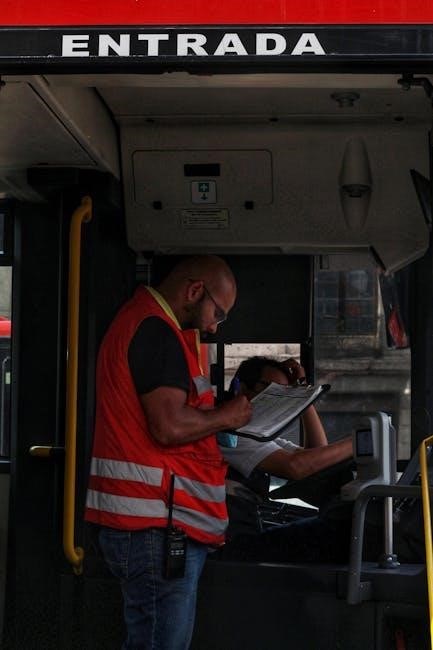NJ Transit 119 Bus Schedule PDF: A Comprehensive Guide

Navigating the NJ Transit 119 bus route requires access to reliable schedule information, often best found in a downloadable PDF format for convenient offline viewing and planning․
Understanding the 119 Bus Route

The NJ Transit 119 bus route is a vital transportation link connecting Bayonne, Jersey City, and New York City, serving approximately 80 stops along its path․ This heavily utilized route provides commuters with a direct option for travel between New Jersey and Manhattan’s Port Authority Bus Terminal․
Understanding the route’s scope is crucial for efficient trip planning․ The 119 operates with varying frequencies depending on the time of day and day of the week, necessitating a review of the current schedule․ Real-time tracking is also available through the NJ Transit app and third-party transit applications, offering up-to-the-minute departure information․ Passengers should be aware of potential service alerts, especially concerning substitute bus services due to unforeseen circumstances like engineer unavailability, impacting regular operations․
Route Overview: Bayonne to New York City
The NJ Transit 119 bus route primarily functions as a commuter line, directly linking Bayonne, New Jersey, to the bustling Port Authority Bus Terminal in New York City․ Originating at JFK Boulevard and 3rd Street in Bayonne, the route traverses through Jersey City, notably stopping at Journal Square, a major transportation hub․
This direct connection makes the 119 a popular choice for residents traveling to and from Manhattan for work or leisure․ The journey typically involves navigating urban traffic, so factoring in potential delays is advisable․ Accessing the latest schedule, whether through the official NJ Transit website, mobile app, or a PDF download, is essential for planning․ Passengers should also monitor for service alerts, as disruptions, including substitute bus services, can occur due to unforeseen operational issues․
Key Stops Along the 119 Route
The NJ Transit 119 bus route features several crucial stops that facilitate convenient access for commuters throughout Bayonne and Jersey City․ Prominent locations include the initial stop at JFK Boulevard and 3rd Street in Bayonne, serving as the route’s origin point․ Journal Square in Jersey City stands out as a significant transfer hub, connecting passengers to various other NJ Transit lines and local transportation options․
Ultimately, the route culminates at the Port Authority Bus Terminal in New York City, providing direct access to Manhattan․ Utilizing a PDF version of the schedule allows passengers to pre-plan stops and connections․ Real-time tracking apps can supplement the PDF, offering up-to-date arrival predictions and alerting riders to potential delays or service changes along these key segments․

JFK Blvd / 3rd St (Bayonne)
JFK Boulevard and 3rd Street in Bayonne serves as the primary starting point for the NJ Transit 119 bus route․ The downloadable PDF schedule is invaluable for passengers initiating their journey here, detailing the first departure times of the day and frequency throughout peak and off-peak hours․ Checking the PDF in advance ensures commuters can align their travel with available service․
Real-time tracking apps, complementing the PDF, provide updates on potential delays impacting departures from this location․ Passengers should also be aware of potential service adjustments, particularly during weekends or holidays, as outlined in the PDF or via NJ Transit alerts․ Utilizing both resources – the static PDF and dynamic app – maximizes travel predictability from this key origin point․
Journal Square (Jersey City)
Journal Square in Jersey City is a crucial transfer hub along the NJ Transit 119 bus route, and the PDF schedule is essential for coordinating connections․ The PDF details arrival and departure times, allowing passengers to plan transfers to other NJ Transit lines or local transportation options․ It’s vital to consult the PDF for accurate timing, especially during rush hour when service is most frequent․
Real-time information, accessible through the NJ Transit app, supplements the PDF by providing updates on potential delays affecting arrivals at Journal Square․ Passengers should also check for service alerts, as outlined in the PDF or on the NJ Transit website, to anticipate any route changes or disruptions․ Effective use of both resources ensures smooth and efficient transfers at this busy transportation center․
Port Authority Bus Terminal (New York City)
The Port Authority Bus Terminal in New York City marks the final destination for the NJ Transit 119 bus, making the PDF schedule invaluable for planning onward travel․ The PDF provides the expected arrival time, crucial for coordinating with appointments or connecting to other transportation modes within the city․ Passengers should familiarize themselves with the terminal layout beforehand, as it’s a large and complex facility․
Checking the PDF alongside real-time updates via the NJ Transit app is recommended, as unforeseen delays can impact arrival times․ Service alerts, detailed in the PDF and on the website, will indicate any potential disruptions affecting the final leg of the journey․ Utilizing both resources ensures a seamless transition from the bus to your ultimate destination within New York City․
Accessing the 119 Bus Schedule
Fortunately, obtaining the NJ Transit 119 bus schedule is straightforward, offering multiple avenues for access․ The primary source is the official NJ Transit website, where a downloadable PDF version is typically available․ Alternatively, numerous third-party transit apps aggregate NJ Transit data, providing digital schedules and real-time tracking features․ These apps often offer a more user-friendly interface for viewing the schedule on mobile devices․
NJ Transit also provides a dedicated mobile app, streamlining access to schedules and real-time information․ Downloading this app allows for convenient, on-the-go access to the 119 bus schedule, alongside service alerts and trip planning tools․ Regularly checking these sources, especially before your commute, ensures you have the most up-to-date information․
Official NJ Transit Website
The official NJ Transit website (njtransit․com) serves as the definitive source for the 119 bus schedule PDF and comprehensive route information․ Within the site, navigate to the bus schedules section, then specifically search for route 119 (Bayonne ⎻ Jersey City ⎼ New York)․ You’ll typically find a downloadable PDF document detailing all stops, departure times, and any relevant notes regarding service variations․
Beyond the PDF, the website offers real-time departure information, allowing you to track the bus’s current location and estimated arrival times․ Regularly checking the website’s service alerts section is crucial, as it provides updates on delays, route changes, or other disruptions affecting the 119 route․ This proactive approach ensures a smoother and more predictable commute experience․
Third-Party Transit Apps
Numerous third-party transit applications, such as Google Maps and Citymapper, integrate NJ Transit data, including the 119 bus schedule․ These apps often present the information in a user-friendly format, offering features like trip planning, real-time tracking, and service alerts․ While these apps don’t always directly host the official PDF schedule, they provide a convenient alternative for accessing departure times and route details on the go․
However, it’s essential to verify the information displayed on these apps against the official NJ Transit website, especially during service disruptions or inclement weather․ Discrepancies can occur, so relying on the primary source ensures accuracy․ Many apps also allow users to set up notifications for specific routes or stops, providing timely updates on delays or changes to the 119 bus service․

Downloading the NJ Transit Mobile App
The official NJ Transit Mobile App is a powerful tool for accessing the 119 bus schedule and real-time information directly from the source․ Available for both iOS and Android devices, the app allows users to plan trips, view departure times, and track buses in real-time․ While the app doesn’t necessarily provide a downloadable PDF schedule, it offers a dynamic and up-to-date alternative․
Downloading the app is straightforward – simply search for “NJ Transit” in your device’s app store․ Once installed, users can input their starting point and destination to receive customized route suggestions, including the 119 bus․ The app also delivers service alerts and advisories, ensuring passengers are informed of any delays or disruptions affecting their commute․ It’s a convenient way to stay connected to NJ Transit’s network․
Real-Time Bus Tracking
Beyond static schedules, NJ Transit offers real-time bus tracking for the 119 route, providing a dynamic alternative to relying solely on a PDF document․ This feature, accessible through the NJ Transit website and mobile app, displays the current location of buses on a map, allowing passengers to pinpoint their arrival times with greater accuracy․
Real-time tracking is particularly useful for mitigating the impact of unexpected delays or traffic congestion․ Users can view estimated arrival times at specific stops, helping them optimize their commute and minimize wait times․ While a PDF schedule provides a baseline, real-time data offers a crucial layer of responsiveness․ The app’s map view allows for visual confirmation of the bus’s progress, enhancing the overall passenger experience and reducing uncertainty․

Utilizing Real-Time Departure Information
Effectively using real-time departure information for the NJ Transit 119 bus complements the static PDF schedule, offering a more dynamic and accurate planning tool․ This data, available via the NJ Transit website and mobile app, displays predicted arrival times at each stop, factoring in current traffic conditions and potential delays․
Passengers can leverage this information to make informed decisions about their commute, adjusting their departure times to minimize wait times or exploring alternative routes if significant delays are anticipated․ The app provides a user-friendly interface for selecting specific stops and viewing upcoming departures․ While the PDF schedule outlines planned timings, real-time data provides a crucial, up-to-the-minute perspective, ensuring a smoother and more predictable travel experience․
Understanding Bus Schedule Variations
The NJ Transit 119 bus schedule isn’t static; it exhibits variations based on the day of the week and specific holidays․ The PDF schedule typically delineates separate timetables for weekday, weekend, and holiday service, reflecting differing ridership demands and traffic patterns․ Weekday schedules generally offer higher frequency and extended service hours compared to weekends and holidays․
Carefully reviewing the appropriate schedule for your travel day is crucial to avoid missed connections or unexpected delays․ Holiday service may operate on a reduced or modified schedule, potentially impacting route coverage and frequency․ Always cross-reference the PDF with real-time updates and service alerts, as unforeseen circumstances can necessitate further adjustments to the published timetable, ensuring a well-planned journey․
Weekday Schedules

The NJ Transit 119 bus weekday schedule, detailed within the PDF document, provides the most comprehensive service throughout the week․ Typically, service begins early in the morning, catering to commuters traveling to New York City, and continues until late evening, accommodating return trips․ The PDF outlines specific departure times from key locations like JFK Blvd in Bayonne and Journal Square in Jersey City․
Frequency is generally higher during peak hours – morning and evening rush – with buses running more frequently to manage commuter volume․ The PDF schedule will indicate express and local service options, impacting travel time․ It’s essential to consult the PDF for precise timings and to plan accordingly, considering potential traffic congestion that may affect adherence to the published timetable․
Weekend & Holiday Schedules
The NJ Transit 119 bus schedule differs significantly on weekends and holidays, as detailed in the downloadable PDF․ Service frequency is typically reduced compared to weekdays, reflecting lower ridership․ The PDF clearly indicates any deviations from the standard weekday timetable, including altered departure times and potential route modifications․
Holiday service may operate on a Saturday schedule, a Sunday schedule, or not at all, depending on the specific holiday․ Always consult the PDF schedule for the relevant holiday to confirm service availability․ Weekend service generally begins later in the morning and ends earlier in the evening than weekday service․ Careful review of the PDF is crucial for planning trips, ensuring you are aware of the reduced frequency and potential service changes․
Service Alerts and Advisories
Staying informed about NJ Transit 119 bus service alerts and advisories is vital, even with the PDF schedule in hand․ Unexpected delays, route changes, or stop closures can occur due to various factors․ The official NJ Transit website and mobile app provide real-time updates, supplementing the static information in the PDF․
These alerts cover a range of issues, from traffic incidents and weather conditions to mechanical problems and planned maintenance․ The PDF schedule itself won’t reflect these last-minute changes, so checking for advisories before your trip is essential․ NJ Transit utilizes social media and email notifications to disseminate urgent information․ Monitoring these channels, alongside the website, ensures you’re aware of any disruptions impacting the 119 bus route and can adjust your travel plans accordingly․
Monitoring for Delays and Route Changes
Even with a downloaded PDF schedule, the NJ Transit 119 bus is susceptible to unforeseen delays and route alterations․ Real-time tracking tools are crucial for staying updated․ The NJ Transit mobile app and third-party transit applications offer live bus locations and estimated arrival times, providing a dynamic view beyond the static PDF․
External factors like traffic congestion, accidents, and adverse weather significantly impact service reliability․ NJ Transit proactively communicates these disruptions through service alerts on its website, social media channels, and within the mobile app․ Regularly checking these sources before and during your commute is highly recommended․ Substitute bus services, as seen with the Princeton Shuttle, may be implemented during emergencies, necessitating awareness of these changes to avoid travel complications․

Impact of External Factors on Service
The reliability of the NJ Transit 119 bus schedule, even when referencing the PDF version, is heavily influenced by external circumstances․ Traffic incidents along the route, particularly impacting major roadways between Bayonne, Jersey City, and New York City, frequently cause delays․ Inclement weather – snow, rain, or extreme temperatures – also disrupts service, potentially leading to route deviations or cancellations․
Unexpected events, such as unscheduled engineering work or personnel shortages, can necessitate substitute bus services, as exemplified by the Princeton Shuttle situation․ These changes require immediate attention to avoid missed connections․ Staying informed through NJ Transit’s official website, mobile app alerts, and social media is vital․ The PDF schedule serves as a baseline, but real-time updates are essential for navigating these unpredictable factors and ensuring a smooth commute․
Princeton Shuttle & Substitute Bus Services
While primarily concerning rail lines, the potential for substitute bus services impacting connections relevant to the NJ Transit 119 route highlights the importance of flexible planning․ Instances like the Princeton Shuttle (Dinky) experiencing engineer unavailability demonstrate how scheduled services can be temporarily replaced․ This underscores the need to check for broader NJ Transit advisories, even if they don’t directly mention the 119 bus․
When substitute bus service is implemented, it can alter travel times and potentially affect connections at transfer points like Journal Square․ Regularly monitoring NJ Transit’s alerts – via the website, app, or social media – is crucial․ The downloadable PDF schedule provides a standard plan, but real-time updates regarding service changes are paramount for commuters relying on the 119 bus to reach their destinations efficiently․
NJ Transit Service Updates & Alerts
Staying informed about NJ Transit service updates and alerts is vital when utilizing the 119 bus․ These notifications can significantly impact your commute, potentially causing delays or route alterations․ The NJ Transit website and mobile app are primary sources for real-time information, detailing disruptions affecting various lines, including those that may indirectly influence the 119 route through connection points․
Even if an alert doesn’t specifically mention the 119 bus, it’s prudent to review it, especially if it concerns areas like the Port Authority Bus Terminal or Journal Square․ Proactive monitoring allows for adjustments to travel plans, preventing unnecessary delays․ While the PDF schedule offers a baseline, it’s essential to supplement it with current alerts to ensure a smooth and predictable journey on the 119 bus․
Finding the PDF Schedule
Locating the official PDF version of the NJ Transit 119 bus schedule typically involves navigating the NJ Transit website․ While direct links can change, a comprehensive search using keywords like “NJ Transit 119 bus schedule PDF” will usually yield the most current document․ Alternatively, exploring the bus route listings on the website and filtering for downloadable schedules is another effective method․
Third-party transit websites may also host archived versions of the PDF schedule, but verifying the document’s date is crucial to ensure accuracy․ Always prioritize the official NJ Transit source for the most up-to-date information․ Once downloaded, the PDF provides a static, offline-accessible resource for planning trips along the 119 route, complementing real-time tracking apps․
Locating and Downloading the PDF Version
To obtain the NJ Transit 119 bus schedule in PDF format, begin by visiting the official NJ Transit website․ Navigate to the “Bus” section and then search for route 119, specifically looking for a link labeled “Schedule” or “PDF Schedule․” Clicking this link should initiate the download․ If a direct link isn’t readily apparent, utilize the website’s search function, entering “119 bus schedule PDF․”

Ensure the downloaded file is from a trusted source – ideally, NJ Transit directly – to guarantee accuracy․ The PDF document will typically contain detailed timetables for weekdays, weekends, and holidays․ Save the file to your device for convenient offline access, allowing you to plan your journey even without an internet connection․ Regularly check for updated versions, as schedules are subject to change․
Tips for Using the PDF Schedule Effectively

When utilizing the NJ Transit 119 bus schedule PDF, familiarize yourself with its layout․ Most PDFs are organized by direction of travel and day of the week․ Pay close attention to footnotes, as they often indicate specific conditions or exceptions to the regular schedule․ Utilize the PDF reader’s search function to quickly locate specific stops or times․
Remember that the PDF represents a static schedule; always cross-reference it with real-time information available through the NJ Transit mobile app or website for the most up-to-date departure times․ Be aware of potential service alerts or advisories that may impact the 119 route․ Printing a copy can be helpful for those without consistent digital access, ensuring you always have the schedule readily available․
Navigating the PDF Document
The NJ Transit 119 bus schedule PDF is typically structured with clear sections delineating weekday, weekend, and holiday service․ Look for a table of contents or bookmarks for quick access to specific timeframes․ Tables within the PDF will list stops along the route, paired with corresponding departure times․ Pay attention to any color-coding or symbols used to denote different types of service, such as limited-stop or local runs․
Utilize the zoom function within your PDF reader to enhance readability, especially on smaller screens․ Many PDFs include a key explaining any abbreviations or symbols used․ Remember to check the document’s publication date to ensure you’re referencing the most current schedule․ Familiarize yourself with the overall document flow to efficiently locate the information you need for your commute․
